
The Acropolis of Athens is an ancient citadel located on a rocky outcrop above the city of Athens and contains the remains of several ancient buildings of great architectural and historical significance, the most famous being the Parthenon. The word acropolis is from the Greek words ἄκρον and πόλις. The term acropolis is generic and there are many other acropoleis in Greece. During ancient times it was known also more properly as Cecropia, after the legendary serpent-man, Cecrops, the supposed first Athenian king.

The Parthenon is a former temple on the Athenian Acropolis, Greece, dedicated to the goddess Athena, whom the people of Athens considered their patron. Construction began in 447 BC when the Athenian Empire was at the peak of its power. It was completed in 438 BC, although decoration of the building continued until 432 BC. It is the most important surviving building of Classical Greece, generally considered the zenith of the Doric order. Its decorative sculptures are considered some of the high points of Greek art. The Parthenon is regarded as an enduring symbol of Ancient Greece, Democracy and Western civilization, and one of the world's greatest cultural monuments. To the Athenians who built it, the Parthenon, and other Periclean monuments of the Acropolis, were seen fundamentally as a celebration of Hellenic victory over the Persian invaders and as a thanksgiving to the gods for that victory.

The Mausoleum at Halicarnassus or Tomb of Mausolus was a tomb built between 353 and 350 BC in Halicarnassus for Mausolus, a native Anatolian from Caria and a satrap in the Achaemenid Empire, and his sister-wife Artemisia II of Caria. The structure was designed by the Greek architects Satyros and Pythius of Priene. Its elevated tomb structure is derived from the tombs of neighbouring Lycia, a territory Mausolus had invaded and annexed circa 360 BC, such as the Nereid Monument.

Priene was an ancient Greek city of Ionia located at the base of an escarpment of Mycale, about 6 kilometres (3.7 mi) north of what was then the course of the Maeander River. It was 67 kilometres (42 mi) from ancient Anthea, 15 kilometres (9.3 mi) from ancient Aneon and 25 kilometres (16 mi) from ancient Miletus. The city was built on the sea coast, overlooking the former Latmian Gulf of the Aegean. It was developed on steep slopes and terraces extending from sea level to a height of 380 metres (1,250 ft) above sea level at the top of the escarpment. Because of siltation from the river filling the bay over several centuries, the city is now an inland site. It is located at a short distance west of the modern village Güllübahçe Turun in the Söke district of Aydın Province, Turkey.
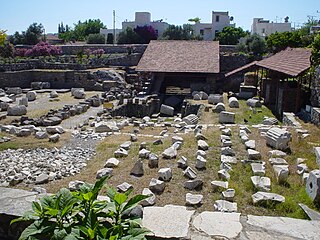
Halicarnassus was an ancient Greek city at what is now Bodrum in Turkey. It was located in southwest Caria on a picturesque, advantageous site on the Ceramic Gulf. The city was famous for the Mausoleum of Halicarnassus, also known simply as the Tomb of Mausolus, whose name provided the origin of the word "mausoleum". The mausoleum, built from 353 to 350 BC, ranked as one of the seven wonders of the ancient world.
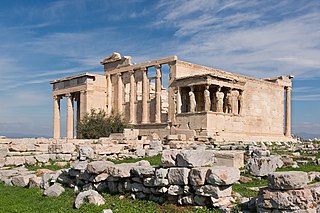
The Erechtheion or Erechtheum is an ancient Greek temple on the north side of the Acropolis of Athens in Greece which was dedicated to both Athena and Poseidon.

Ancient art refers to the many types of art produced by the advanced cultures of ancient societies with some form of writing, such as those of ancient China, India, Mesopotamia, Persia, Palestine, Egypt, Greece, and Rome. The art of pre-literate societies is normally referred to as Prehistoric art and is not covered here. Although some Pre-Columbian cultures developed writing during the centuries before the arrival of Europeans, on grounds of dating these are covered at Pre-Columbian art, and articles such as Maya art and Aztec art. Olmec art is mentioned below.
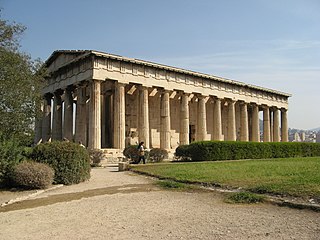
The Temple of Hephaestus or Hephaisteion, is a well-preserved Greek temple; it remains standing largely intact. It is a Doric peripteral temple, and is located at the north-west side of the Agora of Athens, on top of the Agoraios Kolonos hill. From the 7th century until 1834, it served as the Greek Orthodox church of Saint George Akamates. The building's condition has been maintained due to its history of varied use.

The Temple of Athena Nike is a temple on the Acropolis of Athens, dedicated to the goddesses Athena and Nike. Built around 420 BC, the temple is the earliest fully Ionic temple on the Acropolis. It has a prominent position on a steep bastion at the south west corner of the Acropolis to the right of the entrance, the Propylaea. In contrast to the Acropolis proper, a walled sanctuary entered through the Propylaea, the Victory Sanctuary was open, entered from the Propylaea's southwest wing and from a narrow stair on the north. The sheer walls of its bastion were protected on the north, west, and south by the Nike Parapet, named for its frieze of Nikai celebrating victory and sacrificing to their patroness, Athena and Nike.

Pythius, also known as Pytheos or Pythis, was a Greek architect, architecture theorist, and sculptor of the 4th century BC. He designed the Temple of Athena Polias at Priene and the Mausoleum at Halicarnassus, which was regarded in antiquity among the Seven Wonders of the World. It is presumed that he came from the Greek city of Priene. The first-century BC roman architect Vitruvius called Pythius a "celebrated builder" and referenced lost treatises on architecture written in Greek by Pythius as sources for his Latin architecture manual de Architectura (I.1.15).

Rhamnous, also Ramnous or Rhamnus, was an ancient Greek city in Attica situated on the coast, overlooking the Euboean Strait. Its impressive ruins lie northwest of the modern town of Agia Marina in the municipality of Marathon.

The Forum of Augustus is one of the Imperial fora of Rome, Italy, built by Augustus. It includes the Temple of Mars Ultor. The incomplete forum and its temple were inaugurated in 2 BC, 40 years after they were first vowed.
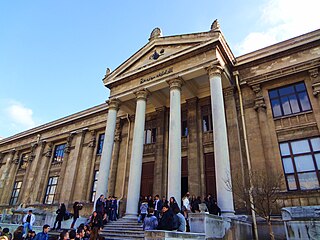
The Istanbul Archaeology Museums are a group of three archaeological museums located in the Eminönü quarter of Istanbul, Turkey, near Gülhane Park and Topkapı Palace.

The Guilford Puteal is a Pentelic marble Ancient Roman sculpture. Its name derives from its use as a puteal or wellhead, and one of its previous owners, Frederick North, second Earl of Guilford. Its discovery in Corinth gives rise to an alternative modern name, the Corinth Puteal.
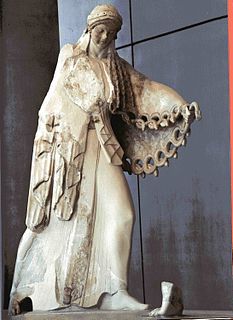
The Old Temple of Athena was an Archaic temple located on the Acropolis of Athens between the Older Parthenon and Erechtheion, built around 525–500 BC, and dedicated to Athena Polias, the patron deity of the city of Athens. It was destroyed by the Persians in 480 BC, during the Destruction of Athens. It was located at the center of the Acropolis plateau, probably on the remains of a Mycenaean palace. The complex is sometimes described by the name "Dörpfeld foundations", after the archaeologist who found the location of the temple. It was referred to as "Archaios Naos" by the Greeks.

The Hekatompedon or Hekatompedos, also known as Ur-Parthenon and H–Architektur, was an ancient Greek temple on the Acropolis of Athens built from limestone in the Archaic period, and placed in the position of the present Parthenon.

The Tomb of Payava is a Lycian tall rectangular free-standing barrel-vaulted stone sarcophagus, and one of the most famous tombs of Xanthos. It was built in the Achaemenid Persian Empire, for Payava who was probably the ruler of Xanthos, Lycia at the time, in around 360 BC. The tomb was discovered in 1838 and brought to England in 1844 by the explorer Sir Charles Fellows. He described it as a 'Gothic-formed Horse Tomb'. According to Melanie Michailidis, though bearing a "Greek appearance", the Tomb of Payava, the Harpy Tomb and the Nereid Monument were built according main Zoroastrian criteria "by being composed of thick stone, raised on plinths off the ground, and having single windowless chambers".

The Lion of Knidos is the name for a colossal ancient Greek statue that was first seen by British archaeologists in 1858 near the ancient port of Knidos, south-west Asia Minor. Soon after it was seen by British archaeologists, the statue was removed to London where it became part of the British Museum's collection. Although there is some debate about the age of the sculpture, in general, scholarly opinion dates it to the 2nd century BC. Since 2000, it has been prominently displayed on a plinth under the roof of the Queen Elizabeth II Great Court.
The Priene Calendar Inscription is an inscription in stone recovered at Priene that uses the term "gospel" in referring to Augustus Caesar. It is called the Priene "Calendar" Inscription because it refers to the birthday of Augustus Caesar as the beginning of an era - the beginning of the gospel announcing his kingdom that heralded peace and salvation for his people - and a Roman decree to start a new calendar system based on the year of Augustus Caesar's birth was published. Calendar dating of history around a ruler is the principle upon which the Julian calendar and Gregorian calendars are based.

The Temple of Athena Polias in Priene was an Ionic Order temple located northwest of Priene’s Agora, inside a complex of the sanctuary. It was dedicated to Athena Polias, the same as the patron deity of Athens. It was the main temple in Priene, although there was a temple of Zeus. It was built around 350 BC. Alexander the Great sponsored constructions of the temples during his anabasis to the Persian Empire. Its ruin currently is at the foot of an escarpment of mount Mycale. It was believed that was constructed and designed by Pytheos, who was the architect of the great Mausoleum of Halikarnassos, which is one of ancient seven wonders, as well. It was one of the Hellenistic temples that was not reconstructed by Romans.


















